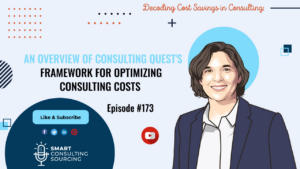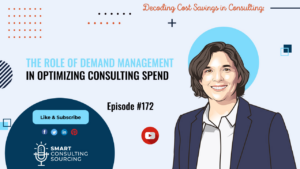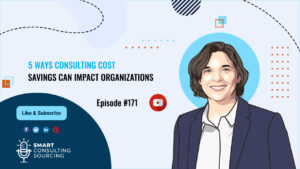Hello and welcome to episode 25 of our podcast: Smart Consulting Sourcing, THE podcast about Consulting Procurement.
My name is Hélène, and I’ll be your host today.
Each week I’ll give you the keys to better use, manage and source consulting services.
This week, I’ll discuss about How to get started to improve your consulting sourcing capability?
Last week, I answered the question “should we freeze our consulting spend during a crisis?”
And we saw that there are four levers that you can use to optimize your consulting spend. Implementing some form of demand management will help you make sure to invest where the most value will be created.
And when you have demand management in place, you can start focusing on selecting the right projects, sourcing the right consultants and managing them to maximize the impact. And of course, this does not prevent you from giving your organization savings targets and but that will ensure you a balanced result.
Get started; Consulting sourcing capability.
So, to come back to improving your consulting sourcing capability, you don’t need to get started with the company-wide transformation.
A simple scan of your consulting expenses can open the door to significant quick wins and value creation. And once you have understood your consulting spend and you have assessed the performance of your suppliers, you can start raking some quick wins.
So, the first thing you need to do is leverage the data you collect. So, now that you have done your diagnosis, you have now in your hands enough to define several corrective actions that will give you immediate results and savings. And you can also slice and dice, find patterns, you know, identify outliers.
There’s many things that you can find by just going a little bit in deep dive into this data. So, for instance, is there a functional business unit that is spending way more money on consulting than the other ones, or either consulting firm that is more expensive than other consulting firms on similar projects.
Either a consultant that is charging more in Europe for instance, than other regions.
Understanding your portfolios of projects gives you the cost to define the basis for improving your sourcing. And in particular that will help you identify the segments and the thresholds for those segments.
Another thing is that if you have an internal consulting group, you can explore how your teams work with this group, why they work with them or not, if their pricing can be compared to external providers, if they collaborate properly with teams, and it can help you compare that performance with the performance of external consultants.
So, with that information you know your panel of consulting firm inside out, both demographic, how it’s organized how many small and big firms, but also how well they perform with you.
And you can improve this panel, you can get rid of the low performers, you can bring in new plots, and playing on supply diversity.
There’s another part that you can do as well is that, now that you can start identifying potential synergy across groups and business units.
And the last part is, now that you know your consulting span, you can refine how you analyze it, how you monitor it, and focus on the elements that are crucial for your company. And this regular analysis can become your long-term monitoring, of your consulting expense.
So, another quick win is to improve your sourcing process. So, you know, among the key success factors for project, outsourcing not actually, you will always find on top the clarity of the scope, and the objective of the project, and the talent of the team and it’s no different for a consulting project.
So, to maximize the chances of success of your project, you need to make sure that you have the expectation laid out very clearly and that’s why we always recommend to put that into an RFP, that stakes clearly the context of the project and the goals and deliverable of the project.
And be careful to describe the result that you’re looking for, but not the means to get that.
Another thing that you can do, is to put your consultant in competition when it’s relevant and to give you a hint, that it’s relevant most of the time. Because one consulting firm can be great on a project but that doesn’t mean that they’re the best choice for the next project.
Besides you might want to look at new ideas and compare with other approaches.
So, going back to how you can optimize your consulting spend, you can now implement some form of demand management, because you need to take control of your expenses in particular if you have a decentralized procurement process for consulting services.
You know, there’s one thing I’ve learned through my career, that last statements of intent are very rarely efficient.
If you don’t have a clearly defined and objective decision-making process to make sure that your budget for consulting is spent on your priorities, that’s not going to happen. And demand management will help you balance and strategically align demand with your consulting budget.
And as you can see it’s not rocket science, so you need to clarify your expectation, you need to better define your process, and spend your money on the most inspired project. And these reactions can get you a long way and improve your bottom line.
Well that’s it for today, next time I’ll explain how to take control of your consulting tail spend.
In the meantime if you have any questions or want to learn more about what we do at consulting quest, just send me an email at helene.laffitte@consultingquest.com
You can also have a look at our website smartconsultingsourcing.com to know more about our book and download free templates and guides to improve your consulting sourcing.
Bye and see you next week! Au revoir!
Consulting sourcing capability Consulting sourcing capability Consulting sourcing capability Consulting sourcing capability Consulting sourcing capability Consulting sourcing capability Consulting sourcing capability Consulting sourcing capability Consulting sourcing capability Consulting sourcing capability Consulting sourcing capability Consulting sourcing capability Consulting sourcing capability







